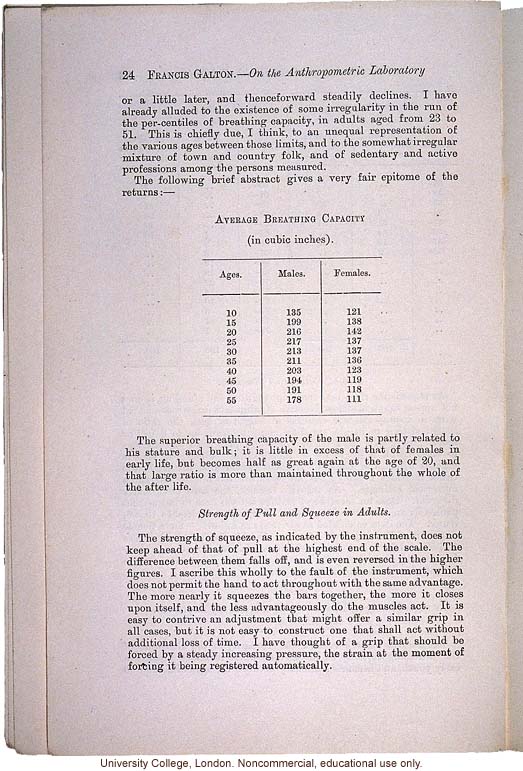24 Francis Galton. --- On the Anthropometric Laboratory
or a little later, and thenceforward steadily declines. I have already alluded to the existence of some irregularity in the run of the per-centiles of breathing capacity, in adults ranged from 23 to 51. This is chiefly due, I think, to an unequal representation of the various ages between those limits, and to the somewhat irregular mixture of town and country folk, and of sedentary and active professions among the persons measured.
The following brief abstract gives a very fair epitome of the returns: --
[tabular material]Average Breathing Capacity
(in cubic inches).
Ages. & Males. & Females.
10 &135 & 121
15 & 199 & 138
20 & 216 & 142
25 & 217 & 137
30 & 213 & 137
35 & 211 & 136
40 & 203 & 123
45 & 194 & 119
50 & 191 & 118
55 & 178 & 111
[end tabular material]
The superior breathing capacity of the male is partly related to his stature and bulk; it is little in excess of that of females in early life, but becomes half as great again at the age of 20, and that large ratio is more than maintained throughout the whole of the after life.
Strength of Pull and Squeeze in Adults.
The strength of squeeze, as indicated by the instrument, does not keep ahead of that of pull at the highest end of the scale. The difference between them falls off, and is even reversed in the higher figures. I ascribe this wholly to the fault of the instrument, which does not permit the hand to act throughout with the same advantage. The more nearly it squeezes the bars together, the more it closes upon itself, and the less advantageously do the muscles act. It is easy to contrive an adjustment that might offer a similar grip in all cases, but it is not easy to construct one that shall act without additional loss of time. I have thought of a grip that should be forced by a steady increasing pressure, the strain at the moment of forcing it being registered automatically.
[end]


